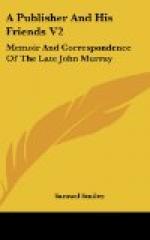In the year following the first issue of the Review, Constable took into partnership Alexander Gibson Hunter, eldest son of David Hunter, of Blackness, a Forfarshire laird. The new partner brought a considerable amount of capital into the firm, at a time when capital was greatly needed in that growing concern. His duties were to take charge of the ledger and account department, though he never took much interest in his work, but preferred to call in the help of a clever arithmetical clerk.
It is unnecessary to speak of the foundation of the Edinburgh Review. It appeared at the right time, and was mainly supported by the talents of Jeffrey, Brougham, Sydney Smith, Francis Horner, Dr. Thomas Brown, Lord Murray, and other distinguished writers. The first number immediately attracted public attention. Mr. Joseph Mawman was the London agent, but some dissatisfaction having arisen with respect to his management, the London sale was transferred to the Messrs. Longman, with one half share in the property of the work.
During the partnership of Murray and Highley, they had occasional business transactions with Constable of Edinburgh. Shortly after the partnership was dissolved in March 1803, Murray wrote as follows to Mr. Constable:
April 25, 1803.
“I have several works in the press which I should be willing to consign to your management in Edinburgh, but that I presume you have already sufficient business upon your hands, and that you would not find mine worth attending to. If so, I wish that you would tell me of some vigorous young bookseller, like myself, just starting into business, upon whose probity, punctuality, and exertion you think I might rely, and I would instantly open a correspondence with him; and in return it will give me much pleasure to do any civil office for you in London. I should be happy if any arrangement could be made wherein we might prove of reciprocal advantage; and were you from your superabundance to pick me out any work of merit of which you would either make me the publisher in London, or in which you would allow me to become a partner, I dare say the occasion would arise wherein I could return the compliment, and you would have the satisfaction of knowing that your book was in the hands of one who has not yet so much business as to cause him to neglect any part of it.”
Mr. Constable’s answer was favourable. In October 1804 Mr. Murray, at the instance of Constable, took as his apprentice Charles Hunter, the younger brother of A. Gibson Hunter, Constable’s partner. The apprenticeship was to be for four or seven years, at the option of Charles Hunter. These negotiations between the firms, and their increasing interchange of books, showed that they were gradually drawing nearer to each other, until their correspondence became quite friendly and even intimate. Walter Scott was now making his appearance as an author; Constable had published his “Sir Tristram” in May 1804, and his “Lay of the Last Minstrel” in January 1805. Large numbers of these works were forwarded to London and sold by Mr. Murray.




